Lingerie style is an invention of world-famous fashion designers Jean-Paul Gaultier and Gianni Versace were the first to use simple, flowing garments made of satin and lace in their collections.
A lingerie-style top made using special patterns resembles the top of a pajama set in its appearance and requires the use of satin or crepe satin in a bright or pastel shade, loosely fitting on the figure with thin straps and decorated with lace ribbons.
Stylistic features of the model
The pattern for a lingerie-style top is made on graph paper using a template.
Sewing a top of such a product requires the use of a light material that flows over the body and emphasizes all its curves:
- silks;
- chiffon;
- atlas;
- crepe satin.
The product is decorated with guipure or delicate lace. It is also acceptable to make such a model from velveteen of a bright, saturated color, decorated with contrasting lace inserts.
In its appearance, the top resembles a shortened women's shirt or part of a pajama set, and its integral part is a deep neckline and thin straps. This model will look most advantageous on slender girls with small breasts. A bust larger than the 2nd size requires adding separately tailored cups to it when making the top, or it can be made in the form of a silk corset.
A typical lingerie-style top has an open back and shoulders, which requires careful attention to the size range. This model can be worn with trousers, shorts, pencil skirts or wide harem pants. It is also acceptable to combine a lace-embellished satin top with skinny jeans.
Despite the openness of the model, it can also be used in a business style, combining it with a strict contrasting skirt, jacket or cardigan that covers the shoulders.
Types of product
Tops that resemble underwear in their shape can have different lengths and styles:
- A top with cups draws attention to the chest area and also highlights figure flaws, so stylists recommend that only very slim girls wear it.
- Loose tops with straps are only acceptable for women with a bust size of 0 to 2. On a larger bust, such an outfit will look quite vulgar.
- Tops with frills on the chest are used to add extra volume to the décolleté area.
- Tight-fitting lingerie-style tops go well with trouser suits and jeans and are recommended for women over 168 cm tall.
Depending on its length, the top can:
- reach to the waist and have a loose fit;
- be made in the form of a crop top ending above the waist, which goes well with jeans or shorts and is complemented by a jacket or cardigan;
- extended to the size of a tunic;
- resemble a satin slip with a length to mid-thigh. Such a top necessarily has thin straps, and lace is used as decoration.
Necessary materials and manufacturing features
The lingerie-style top is made using fairly simple patterns. The only difficulty here may be working with creasing and crumbling satin or silk fabric. Necessary materials:
| Main fabric | To make the top you can use:
|
| Decor | Lace or edging is most often used as a top decoration, sewn along the entire chest line and along the bottom edge of the product, or used to create a second layer, over the main fabric. For edging, you need to choose a contrasting lace or one that matches the tone of the main material, 1.5 m long. |
| Straps | The straps for the product can be made independently from the main fabric or you can use a 1 m long braid as a replacement. |
| Additional materials |
|
During operation, the sewing machine should first be set to the overlock foot for processing the side edges of the product, and then to the regular stitch foot.
Threads for making the top are selected in 2 types:
- contrasting with the main material and used at the cutting stage, and basting of the product;
- matching the color tone of the product used for machine stitching.
When creating edging, it is necessary to select threads that exactly match its shade, which will make the seams as invisible as possible on the finished product.
The top pattern contains 4 parts:
- The front part of the product with a fold.
- The back consisted of 1 or 2 parts.
- A hem in the form of a rhombus (oval) with a width of 3–4 cm, varying depending on the chosen type of neckline. The length of this element should always correspond to the size of the head opening.
- Strapless.
When cutting out a product, experts advise novice seamstresses not to forget about the seam allowance, leaving 1.5–2 cm along the edges of the pattern (except for its lower part).
As a template for the top, you can use patterns from the Internet or from the Burda magazine. If you have difficulties taking measurements and cutting the fabric, experts advise using any top you have in your wardrobe as a sample.
After taking the product, it needs to be ironed, carefully laid out on the wrong side of the fabric chosen for sewing and outlined with a pencil or tailor's chalk, having first left 1.5–2 cm on each side for seams.
The resulting pattern should be carefully cut out with scissors, then the edges should be processed from the inside with an overlock and the finished top should be basted by hand. After trying on the top, it can be machine stitched and ironed well.
The products can be decorated with lace attached to the triangle of the bodice and the straps of the top.
The edging of the finished product is done manually or with the help of a special device, the price of which is about 7,000 rubles. With its help, you can decorate any outfit without the risk of possible mismatch of the seams on the edging and parts of the main product.
Since satin, silk or crepe satin are quite difficult to work with due to their tendency to fray easily, professionals advise novice seamstresses to use lightweight cotton fabric for making tops, decorating it with lace or braid. This option will allow you to practice and then apply the acquired skills when working with satin or silk material.
How to make
The pattern of a lingerie-style top, transferred to satin or crepe-satin fabric, allows you to create a universal part of any woman's wardrobe, acceptable in both business and casual styles and goes well with jeans, formal skirts or trouser suits.
- To make a top from fabric, you need to cut out all the details of the product. To do this, the pattern downloaded from the Internet or a magazine must be applied to the fabric with a pencil, tracing the pattern along the contour and be sure to add an allowance for the seams (1.5-2 cm).
- At the end of the dart, you need to tie a knot, and then thread a thread through its thickness using a needle. The resulting darts need to be ironed upward.
- Each of the straps should be folded face-to-face, stitched along the entire length and ironed well. The finished strap should be turned right-side out with a wooden skewer or hairpin. The turned-out straps should be ironed well.
- The parts intended for facing should be stitched along the side seam and the allowances should be ironed. The facing part of the top should be copied onto the interlining used as a lining and carefully cut out without additional allowances for the seams.
- The facing made from the main fabric should be applied face down to the interlining, basted, and then stitched together along the bottom edge. The remaining allowances should be cut off (up to 3-4 mm of fabric). On the resulting product, you need to carefully bend the interlining upwards and iron the allowance without going beyond its borders.
- Turning the interlining over to the wrong side, you need to align the edges of the facings, and then glue the lining with an iron to the wrong side of the top. The excess interlining needs to be cut off.
- The chest and back patterns of the top should be placed wrong sides together and basted along the side seam at a distance of 5 mm from the edge of the product. The resulting product should be carefully stitched, and then the seams should be ironed on either side. The remaining fabric for the allowance should be cut off, and the finished top should be turned inside out and the side seams should be laid, hiding their allowances inside the product.
- The straps of the top should be pinned to the main garment so that they point downwards.
- The facing parts should be stitched along the second side seam, and then, placing the facing on the top with the right side facing, stitch the garment, leaving the places where the straps are attached open.
- After turning the garment inside out, you need to try it on to determine the length of the straps, and then fix them by stitching the unclosed areas of the top.
- The armhole areas should be cut to prevent the seam from pulling up.
- The top and facing pieces need to be laid out with the front sides facing in different directions.
- On the wrong side, in the facing, you need to make a line 1 mm from the seam, fixing the allowance. Having turned the facing, you need to iron the seam on the wrong side so as to hide it from the front side.
- The bottom of the top needs to be folded over by 3 mm, and a stitch needs to be made 1 mm from the fold. The remaining 2 mm allowances need to be cut off.
- Once again, fold the seam over and make a stitch at a distance of 3 mm from the edge (getting exactly into the previous seam). The finished top needs to be ironed well, paying attention to each of the seams.
Top with ties and wide straps
The pattern for a lingerie-style top with ties should be made from satin or silk up to 70–80 cm long, which allows the finished product to reach the middle of the girl’s thigh.
To make a top with ties at the front and wide straps, you will need a pattern from the Burda magazine and satin or crepe satin fabric.
Manufacturing stages:
- The bindings intended for edging the neck and armholes should be cut so that they are 3 cm wide. The length of the binding is determined by the cuts in the finished form.
- When making a separate neckline trim, part of it should be cut to the middle of the torus, and the other part should be left for the neckline and tie.
- After folding the two parts of the product together, they need to be sewn along the shoulder and side seams.
- The remaining allowances need to be overcast, excess fabric trimmed and ironed.
- The bottom of the top needs to be overcast and hemmed along the bottom edge at a distance of 3 mm from it.
- The edges of the product and the neckline must be edged with piping.
- When forming the shoulder seam, place cotton tape underneath and stitch. The remaining allowances should be cut off and the seams should be ironed well.
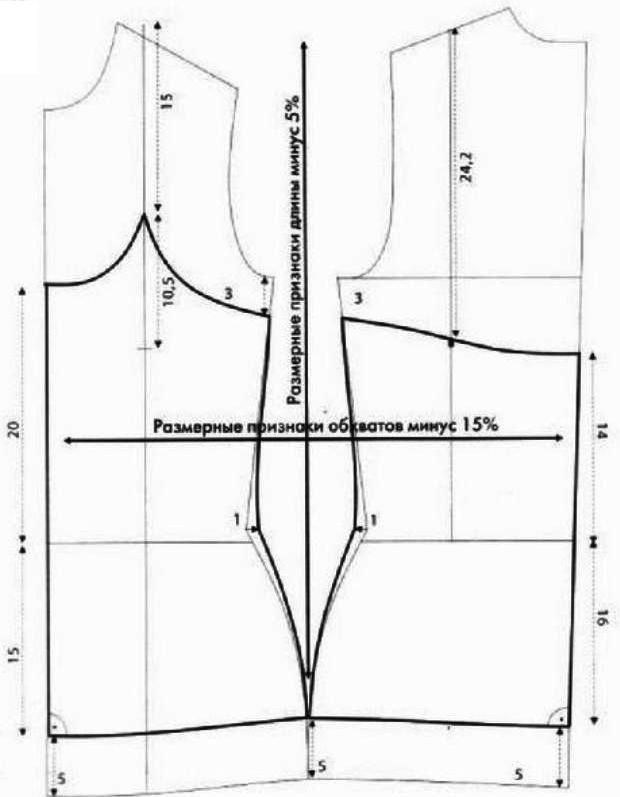 The presence of wide straps suggests using the top without an additional cardigan, as well as a possible combination with shorts or a short skirt.
The presence of wide straps suggests using the top without an additional cardigan, as well as a possible combination with shorts or a short skirt.
With lace trim
The pattern of the lingerie-style top with lace trim has inserted cups, allowing even curvy girls to wear it.
Progress of work:
- All parts of the pattern must be transferred to the fabric from the back side. To do this, the paper pattern must be traced with a pencil (tailor's chalk), leaving the required seam allowances of 1.5–2 cm.
- On the cut out pieces of the product, the neckline should be edged with an overlock.
- The front and back parts of the top need to be placed on top of each other and basted, then stitched with threads that match the color of the fabric along the side seams.
- The edges of the resulting product should be overcast, and the cuts should be smoothed out well and stitched with finishing tape (piping).
- You can decorate the top with lace ribbons. To do this, you need to sew it with a zigzag stitch along the top of the front side of the main fabric on the front part of the product.
- The cups of the top need to be cut out of thick foam rubber and sewn to the inside of the chest of the product, creating a beautiful neckline.
Top with edging
The pattern of the lingerie-style top with lace trim makes the product look like the top of a pajama set and is combined only with a strict bottom that matches the shade of the lace.
The edging complements the finished product, but unlike lace, it does not attract increased attention.
When making such a top:
- The paper pattern taken from the Internet or the Burda magazine must be transferred to the fabric chosen for the top from the back side. The pattern fixed on the material must be traced with a pencil or tailor's chalk with a mandatory seam allowance of 1.5–2 cm.
- All parts of the product must be cut out, placed face to face, basted first, and then stitched along the side lines.
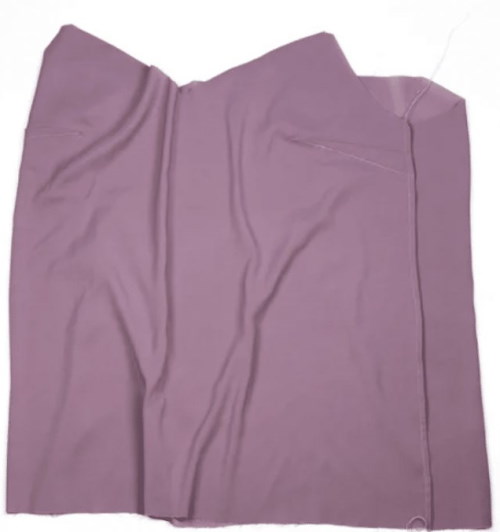
- From the main material, using the pattern, you need to make 2 thin straps, stitching them along the side seams, and then ironing and turning them to the front side.

- The finished straps should be sewn first to the back, then applied to the front of the top, pinned and sewn to the main product.

- Moving along the perimeter with an indent of 3 mm from the bottom edge, the bottom of the model is stitched.
- The finished product must be ironed well and the edges of the seams must be processed with an overlock or a soldering iron.
- To decorate the top, the facing should be placed on the front side of the finished product and, having aligned the edges, first baste it and then stitch it. In the finished product, the shoulder and side seams should match the facing seams.

Top from an old tank top or t-shirt
The lingerie style top pattern can be made from any old tank top or t-shirt that has:
- To create a semicircle shape, you first need to cut off the existing sleeves, and then remove the bottom part of the garment using a semicircle or straight cut.
- Before removing the bottom part of the T-shirt, you need to leave a few strips on it to form the ties of the top, and remove the rest with scissors.
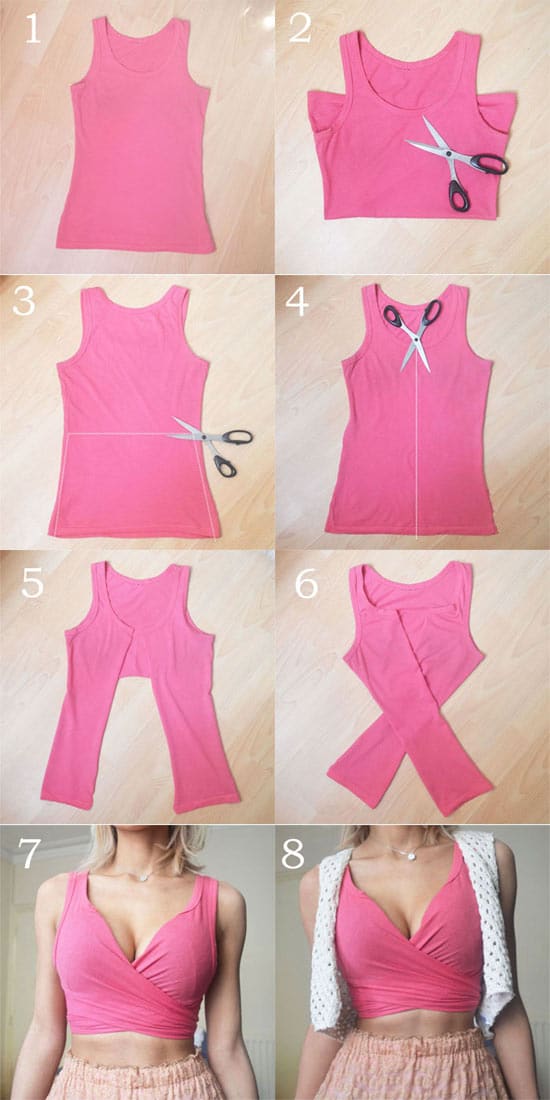
- The lower part of the product can be cut to the shape of an unbuttoned shirt, and the resulting strips can be tied around the girl’s body.
Lace top
The pattern for a lingerie-style top made of artificial lace does not require preliminary redrawing of the pattern.
To make a lace lingerie style top:
- The prepared pattern must be laid out on the wrong side of a piece of lace fabric 60–70 cm long and pinned.
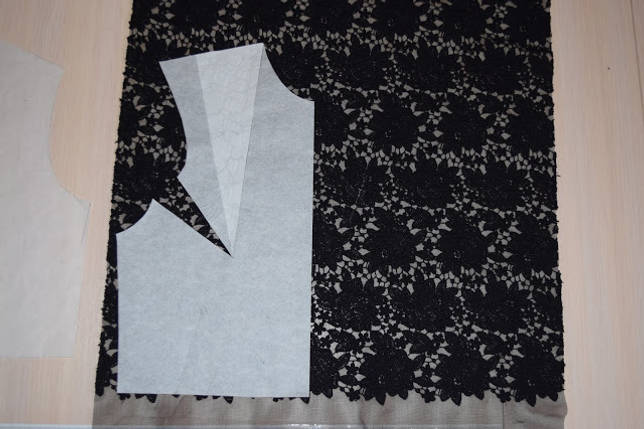
- Before reaching the embroidery, 1–2 mm of the mesh should be cut with scissors and the top shelves should be cut out, leaving a 1.5–2 cm allowance for the cuts.
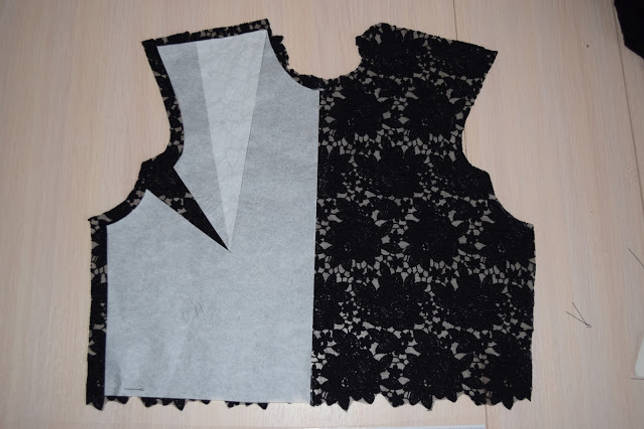
- Proceeding in a similar manner, you need to cut out the back of the product from the reverse side. Here, the neckline should be cut not in a broken semicircle, but in the shape of a drop, so that it is easier to put the top on over the head. Subsequently, you can put a button here, securely fixing the product on the female body.
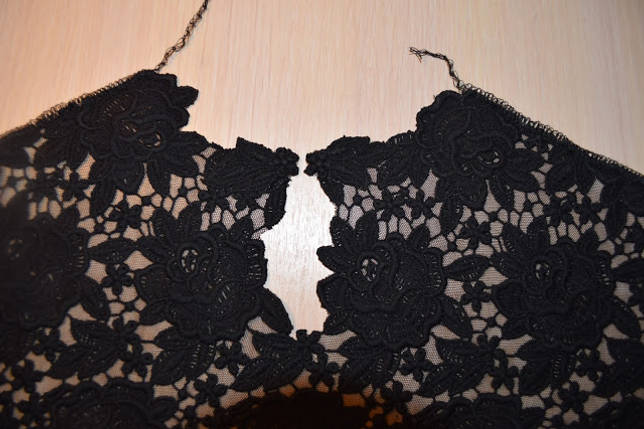
- All parts of the pattern in the shoulder and side cuts must be processed on an overlock machine, and then connected together with a machine seam.
Tips for making
Making a lingerie-style top pattern yourself requires special skills in working with satin and silk materials.
Experts advise beginning seamstresses:
- Store the material selected for work in a folded state, with the front side up. Satin or silk fabric should only be stored in a container made of natural materials, since polyethylene has a negative effect on its condition, leading to wetting of the fabric and rapid loss of color.
- Cut satin or crepe satin fabric only with very sharp scissors and apply slight tension, and allow the cut parts of the garment to “rest” for some time before sewing.
- When sewing, pull the material tight to prevent unwanted snags, and use only thin, sharp needles for your sewing machine, designed for working with satin or silk fabric.
- Choose a short stitch length when sewing a product, which will allow the sewing machine to run smoothly.
- Before decorating the product with lace or edging, as well as finishing the work, it is necessary to process the ends of the product with a zigzag stitch.
- You can decorate a lingerie-style top with lace that matches the shade of the main fabric of the garment. You should decorate the top only after it is completely stitched and its edges are finished with a zigzag stitch.
To decorate the top:
- The lace strip should be applied to the front side of the garment and first basted, then stitched to the top using threads that exactly match the shade of the selected lace. This is done so that the seams are not visible on the finished top.
- The edging of the product is done in the same way as lace decoration, except that in this case stylists recommend choosing a edging shade that contrasts with the color of the main fabric of the product.
A lingerie-style top is a bright, basic item of a capsule wardrobe, beautifully emphasizing the curves of a woman's body. Made from flowing silk or satin fabric, such a top does not require special skills and can be sewn at home using patterns taken from the Internet or magazines, and also decorated with tape or lace, giving it a piquant resemblance to pajama sets.
Lingerie Style Top Video
Construction and pattern of a lingerie top:
